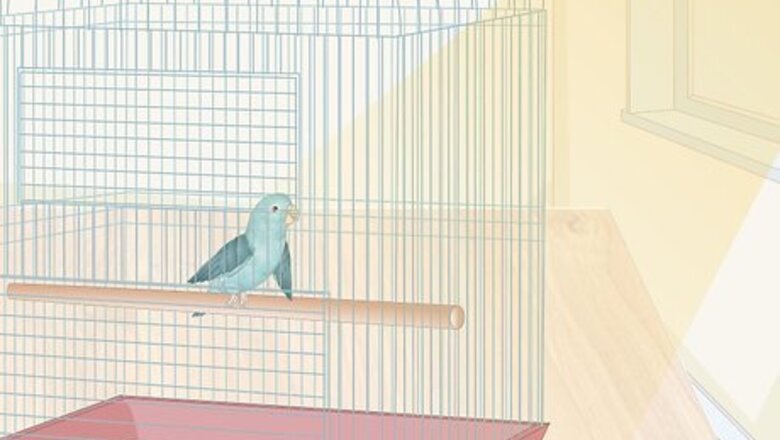
views
Introducing Two Birds Gradually
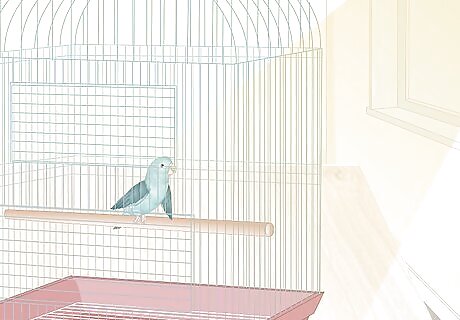
Quarantine a new bird for at least 30 days. If you've gotten a new bird, you cannot place it in the same cage as your other birds immediately. The bird must first enter quarantine to ensure it isn't sick. Keep the new bird alone in a cage with food, water, toys, and other essentials. Put the cage in a separate room away from your other birds. If you notice any signs or symptoms of illness in the new bird, bring it to an avian vet immediately. You can work on taming this new bird during the quarantine period. To keep the all of your birds healthy during this time, always take care of the old bird before the new bird to prevent contamination.
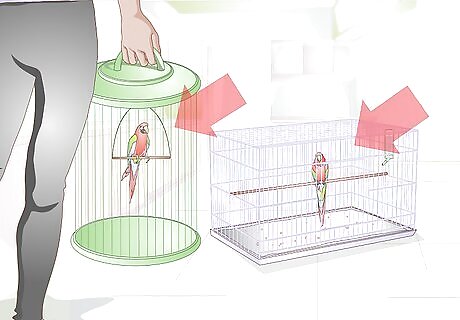
House both birds in separate cages. For a gradual introduction, you should keep the birds in different cages for at least 30 days. After the quarantine period, you can try placing the cages near each other, but if either bird seems stressed, place them at a greater distance.

Look for signs of stress. If either bird experiences stress, you should try to minimize it. Signs of stress include picking at feathers or skin, squawking or vocalizing loudly, and pecking or flapping its wings aggressively. If you see any behavioral or physical abnormalities, take the bird to the vet.
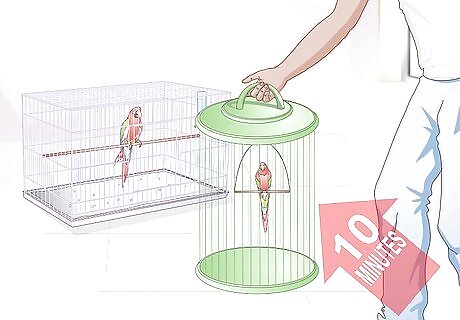
Make brief introductions in a neutral room. In other words, if your bird lives in its cage in the living room, bring it into the basement or another room to meet its new friend for the first time. Keep these initial introductions down to ten minutes or so. Place the cages in the same room for about ten minutes or so, then remove them to their separate rooms.
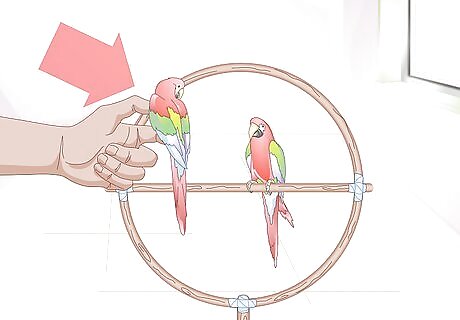
Let the birds play in a common area when they’re comfortable. Let both birds out of their cages in the common, neutral room and let them interact. You could provide a playstand for the birds to hop and fly around on.
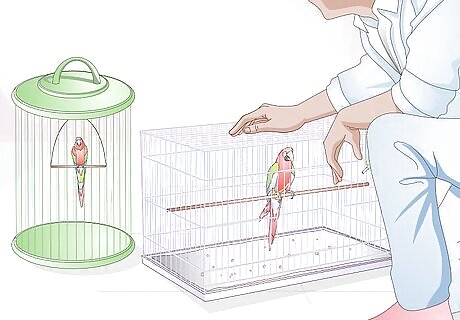
Always greet your original bird first. When entering the room with the new and original bird, you should take both out of their cages for a short time so they can look around the neutral room and observe the other bird. However, to ensure your original bird doesn’t feel that it’s being supplanted, take it out first. If you want to give your birds treats, give one to the original bird first, then give one to the new bird.
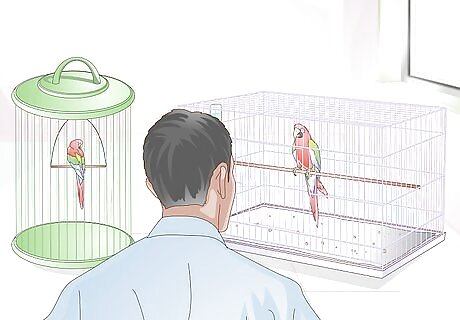
Remain present when introducing the birds. Do not put two new birds together and leave the room, even if they are in separate cages. This could cause undue stress for both birds.
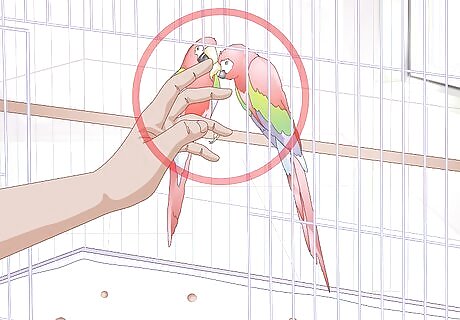
Stay aware of potential problems. Keep an eye out for conflict between the birds. Biting, screaming, squawking, or other negative behaviors should be dealt with by placing both birds back in their cages for a time-out. If your bird scratches or claws at its own feathers or skin, it might be appropriate to separate it from the other bird.
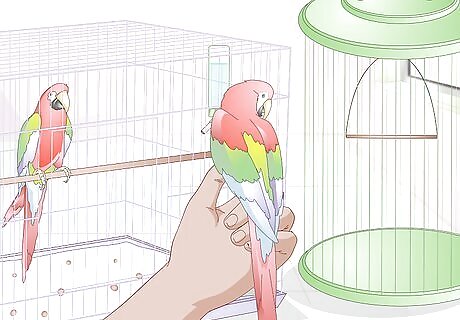
Do not expect the birds to act the same. All birds have unique personalities and temperaments. Certain actions or sounds might trigger one bird but not the other. For example, one bird might tire quickly of playing with another, and need to be put back in its own cage. Stay conscious of differences in personality between the two different birds when deciding how to treat them.
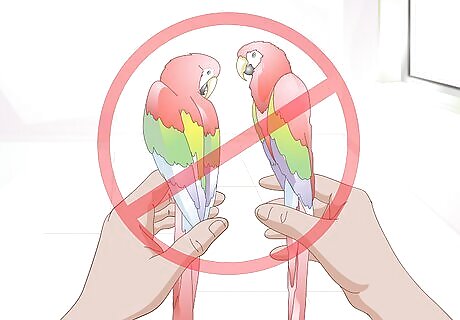
Don’t force a relationship. Some birds get along great together. Others take time but will eventually warm to one another. Other birds will never get along well together. Recognize when birds do not get along and respect their wishes by not placing them together.
Introducing Two Birds to Each Other As Mates
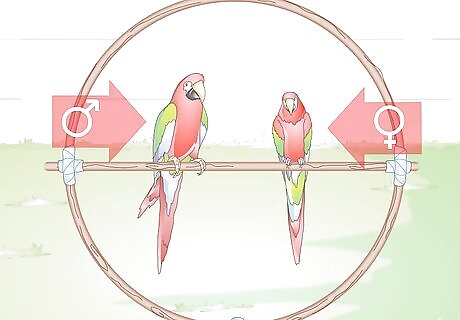
Ensure your birds are of different genders. Within a given species, larger birds are generally male and smaller birds are female. If your birds are of the same size, or if you are unsure of your bird’s gender, consult a veterinarian.
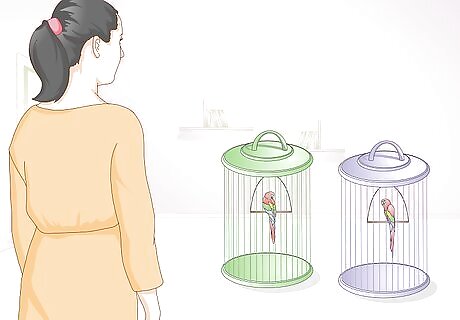
Stay in the room with both birds when first introducing them to each other. The first time you introduce the birds, you should plan on staying present with both for at least one day. This applies whether you choose to put both birds together in one cage from the start or to introduce them to each other slowly. Keep two bird nets and a pair of gloves on hand to prepare for the possibility that you’ll need to separate them.
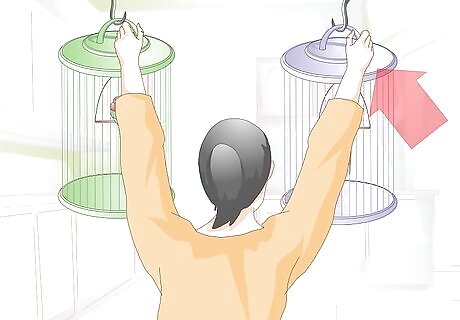
Gradually introduce the birds to each other. Place the birds in two separate cages. Hang the cages next to one another. After a period of time, they will become comfortable with one another. How long it takes them to become used to one another depends on the birds. Since all birds are different, with unique personalities, likes, and dislikes, the rate at which they become comfortable with one another will vary.
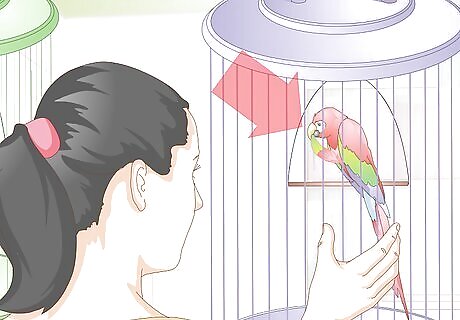
Look for signs that either bird is stressed. If your bird is stressed due to close proximity to another bird, it might pick its feathers or skin, lose weight or lose its appetite, drink and urinate excessively, peck people who handle it, squawk noisily, or pace back and forth on its perch. Look for these and other behavioral abnormalities particular to your bird in order to determine if it is stressed. Introduce the mates to each other when their stress levels have subsided. If the birds show signs of stress, place the cages further apart from each other, rather than directly next to one another.
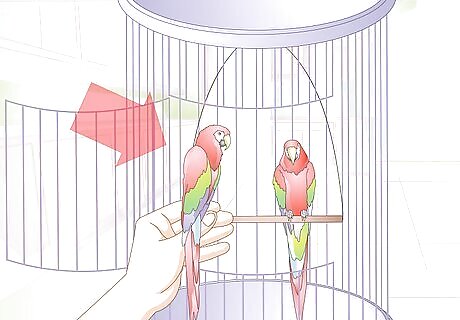
Put the birds together in a new cage. If you do not want to introduce the birds to each other gradually, you can simply place them together in one cage as soon as the new bird has ended its quarantine period. Place both birds in a flight cage which both are unfamiliar with. The confusion of being thrust into a new environment with another bird will eliminate the sense of territoriality which might accompany a bird being introduced to a cage which another bird already identified as its home.
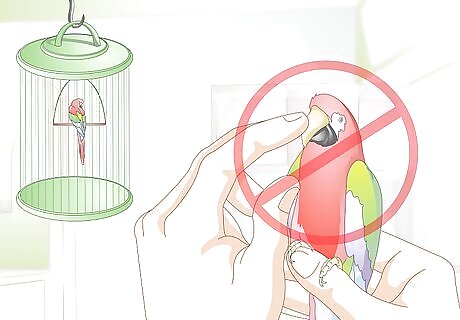
Stop treating the birds as pets. If you treating the birds as pets and show affection to one or both of them, they might become jealous of each other. To ensure a harmonious mating, act in a disinterested way toward your birds. Feed and water them regularly as before, but let their interactions replace the stimulation you would normally provide. Do not hand the birds treats directly. If you want to give one or both of them treats, leave the treat on the floor or on a perch of the cage. Do interact with them in any way, including by talking to them or taking them out to teach them tricks. If other people in your household are also attached to the birds, they should stop seeing them as well.
Thinking About Expanding the Flock
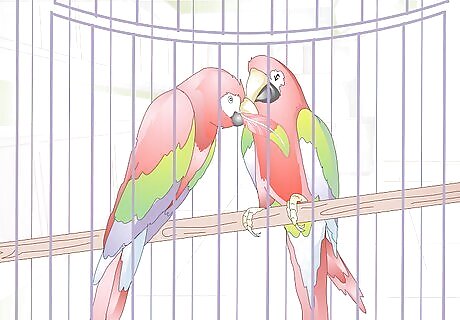
Analyze your bird’s personality. If you know your bird does not play well with other birds, do not introduce your bird to others. One or the other of the birds could get hurt. You could get hurt too if your bird is introduced to another while sitting on your arm or shoulder.
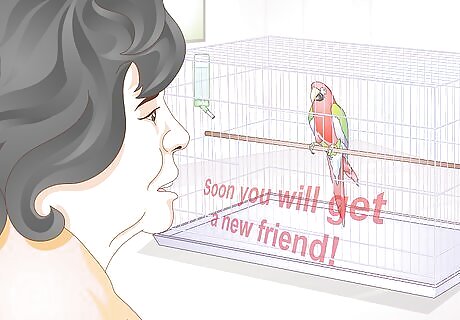
Tell your bird it will soon get a new friend. Say to your bird in an enthusiastic tone, “Soon you will get a new friend,” or “Are you excited to meet another bird?” You can tell your bird of the impending introduction a few days or a few hours before the introduction. While birds might not understand English (or any other language), they will recognize when something big is about to happen. Keeping your bird informed of situations that concern them is as important as it would be with any other member of your family.
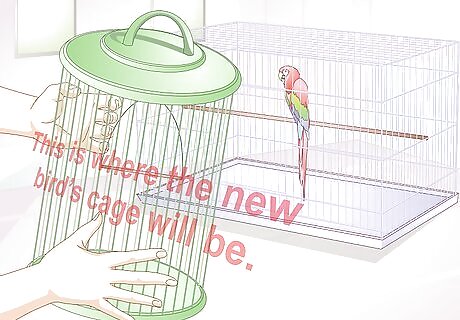
Permit your bird to see your preparations. Introducing two birds to each other often means introducing new equipment into the mix. If you are moving a new cage into the house, for instance, let your bird see it. You can draw your bird’s attention to the cage by commenting, “This is where the new bird’s cage will be,” or something along those lines. You should let your bird see the new cage a few weeks before the new bird arrives.

Place a substitute in the new bird’s cage. To help your bird understand that it will soon have a new friend, you should add a stand-in for the new bird to the new cage before the bird arrives. For instance, you could place a stuffed animal on the perch in the cage, or lay a sock similar in color to the bird you’ll soon be introducing to your existing bird over the perch.
Maintaining Normalcy
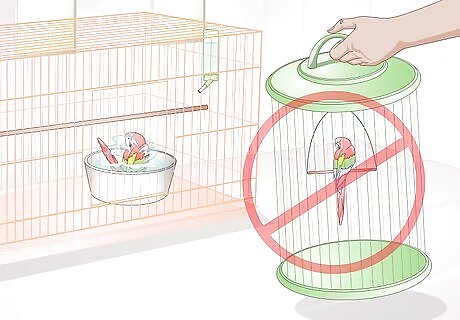
Minimize disruptions to your bird’s schedule and lifestyle wherever possible. For instance, do not introduce a new bird to your bird during the time that your bird would normally be taking a bath or having a meal. If you need to move your bird’s cage in order to make room for the new bird, do so well in advance of the new bird’s arrival.
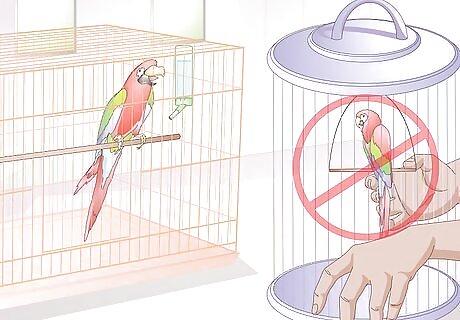
Respect your original bird’s boundaries. For instance, do not give your old bird’s cage to the new bird without repainting it or altering its appearance significantly. If you do not, the bird that used to live in it will be jealous and could cause conflict. Similarly, do not place a new bird’s cage right next to your original bird’s cage if it makes your original bird uncomfortable.
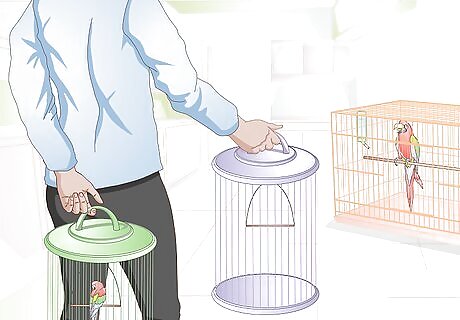
Don’t overwhelm your bird with many new experiences. For instance, if you decide to purchase a new cage for your original bird at the same time that you purchase a new bird (and cage), keep the new bird out of view until your original bird has acclimated to the new cage. Depending on the bird, it may take a few days to a full week.
Keeping Your Birds Healthy

Identify birds which might need to be quarantined. If introducing a new bird to your bird who has not received shots or been examined for potential illnesses, your bird could get sick. Birds that have come from closed aviaries do not need to be quarantined. Similarly, birds which have been check by a vet before leaving a reputable bird or pet shop do not need to be quarantined. For all other birds, take them to a vet and follow your vet’s quarantine instructions in order to ensure the new bird does not introduce any illnesses to your original bird.

Take your new bird to the vet. Find a vet who is familiar with avian illnesses and can provide directions on how long to quarantine your new bird. Use the Association of Avian Veterinarians database (https://www.aav.org/search/custom.asp?id=1803) to find a bird vet near you.
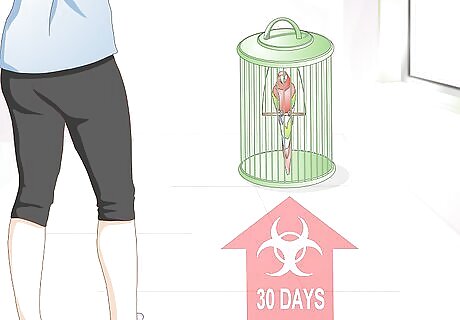
Keep your new bird in quarantine. Quarantine requires keeping a new bird whose health status you do not know away from a bird that you know to be healthy. Quarantine periods last from 30 to 90 days, depending on the bird. Before introducing two birds to each other, ensure both have seen a vet recently. If one has not, quarantine it in a separate cage and room.













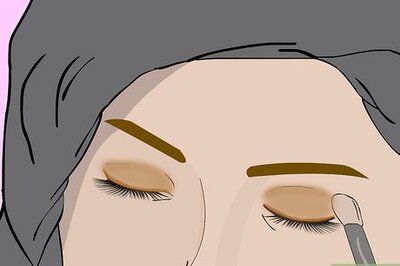

Comments
0 comment